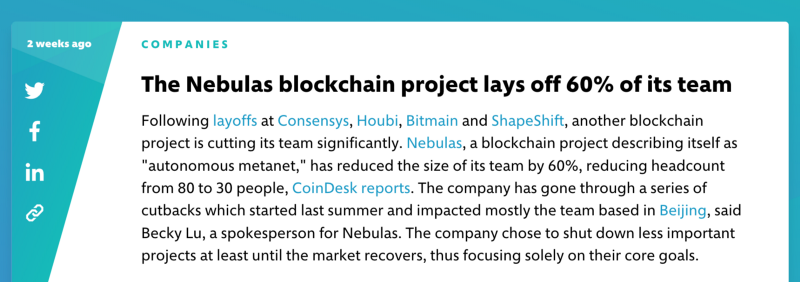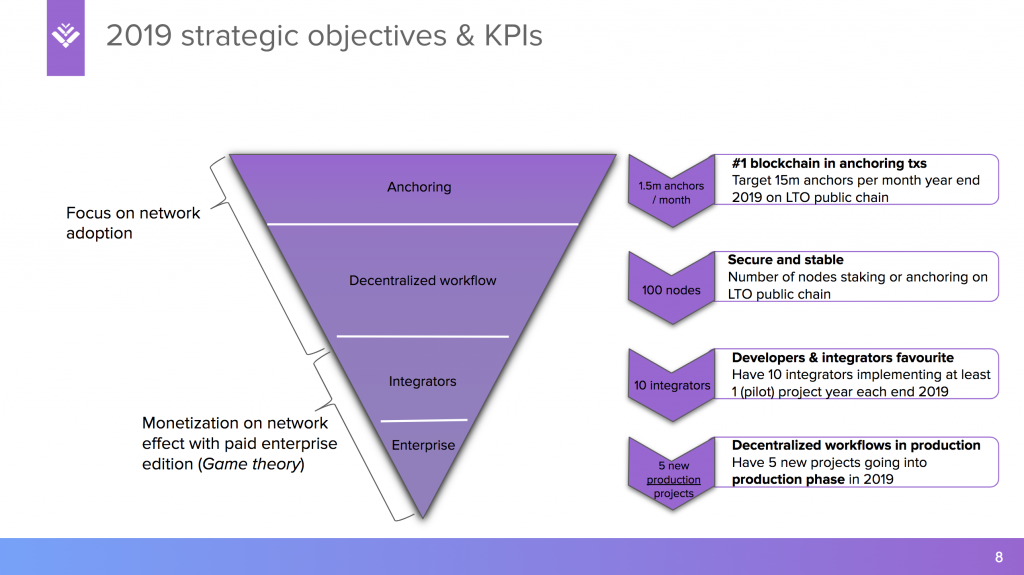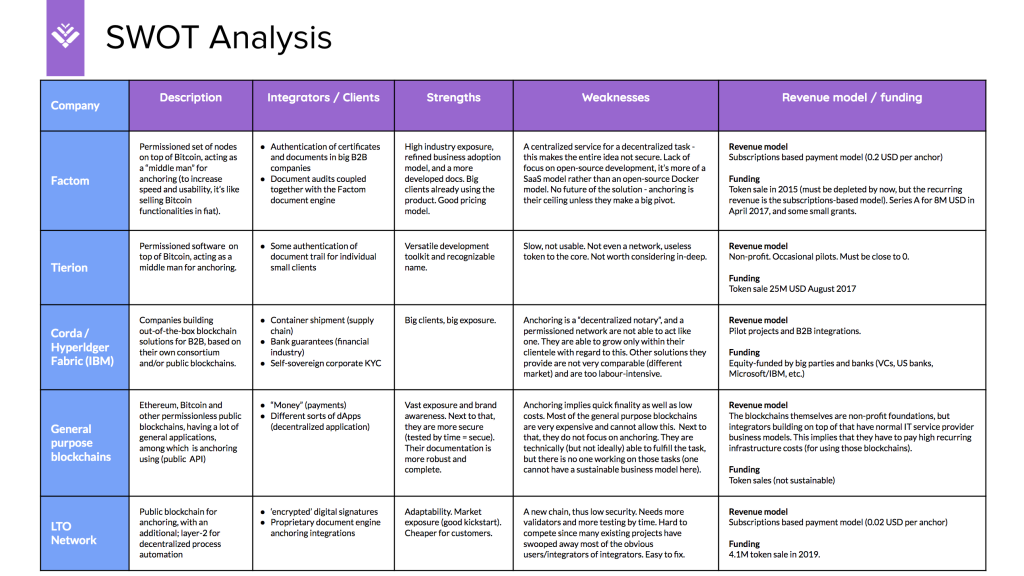Strategic Business Plan for 2019: Blockchain Adoption
We will drive you through the ways in which LTO Network creates value (technology), what value we create (product) and how we capture and maintain this value (token economy). Read further for our strategic business plan for blockchain adoption and the SWOT analysis!
Website | Telegram | Twitter | Reddit | LinkedIn
We will cover the ways in which we approach the product, what the product is, and how we will maintain the product. Warning: you will need about 5 cups of tea. Or maybe something stronger. 🍸
2019 has passed, and it was a great success - LTO Network became top-25 most used blockchain! In 2020, we are going to be targeting even more users, check out end of the 2019 report.
Conceptual understanding of LTO Network
What is LTO Network’s tech and what can you do with it?
In short, the private layer is for data sharing and process automation (each process residing on its own miniature ad-hoc permissionless private chain). The public layer acts as a global security settlement layer — an immutable digital notary. This hybrid approach makes LTO Network GDPR and data privacy compliant, as well as scalable and ready for adoption.
Sounds pretty versatile, right? The toolkit has endless use cases. Essentially any deterministic inter-party process or legal agreement can be automated as a Live Contract: supply chain processes, third-party data handling etc.
But even more cases are “hidden” in LTO Network’s anchoring layer. There is an urgent need for companies and document management systems providers to create trustless and secure audit trails, to make sure data is not manipulated.
Ok, I understand the use cases — anybody already implementing it?
Blockchain use cases are very broad and quite often the technology is applied incorrectly. For the blockchain to show…
We have several big clients in the real estate market (such as MSeven, OSRE, Merin, Stena & CMS Law), as well as in the insurance market (DEKRA). These companies use anchoring for trusted timestamps and audit trails. Also watch out for our supply chain solution for waste transportation throughout Germany, The Netherlands, and Belgium. This solution is comprised of decentralized workflows, notary services, anchoring, and more.
How does the token come into place?
We often hear the following objection: “It is not realistic to expect a corporation or a government to go to some exchange and buy your tokens to be able to use your product.”
However, there has to a be way for clients of different blockchain expertise (think B2B or any user-focused project) to be able to interact with your solution without this friction, YET have the token be an integral part of your product. We solved this by merging the token holder community with users:
“Companies that are not 100% familiar with blockchain or token markets do not need to concern themselves with acquiring tokens. Those with LTO tokens can lease out their tokens to XYZ for example — or XYZ can have tokens staked by their integrator. Of course, if clients want to buy tokens, they are free to do so. In any case, LTO tokens are used at all times — whether companies purchase or lease them.”
Rick Ros, Altcoin Magazine
Let’s sum it up.
- How LTO Network creates value (technology) — hybrid blockchain approach where you can both determine custom logic and use anchoring for security against data manipulation.
- What value LTO creates (product) — there is a two-layer adoption strategy as well: anchoring as a stand-alone feature and decentralized workflows which can be used for any inter-party process or business procedure.
- How LTO captures value (token economy) — staking performed by clients, integrators, and community token holders. More adoption results in higher token reservation time (bonded by nodes), while there is no network inflation. For all the details, please read our tokenomics paper.
Ok, now that we have everything covered conceptually, let’s get into the details.
Strategic Plan of LTO Network for 2019
Mission statement and goals of LTO Network
LTO Network enables collaboration between multiple organizations and departments via decentralized workflows, in which parties can keep using their own (legacy) systems to participate in a process.
Cool mission, but how are we making it happen?
Why other projects die — and how we intend to change that

Projects that did not focus on long-term sustainability and their product have failed in less than a year.
The biggest waste of all is building a product that customers refused to use — Eric Ries, The Lean Startup
Often, when a foundation stops working on a project, no one is left to use the token. Bitcoin and Ethereum have large decentralized communities, which solves this issue. But other projects cannot compete with that. After all, not all decentralized projects have huge communities that maintain the platform. Other teams require something more sustainable to keep building. This is why we have implemented the open-source business model used by Docker.
We released mainnet and provide toolkits to build decentralized workflows. Any IT company, integrator or startup can use the toolkit to build their own solution. Also, we constructed the token economy in such a way that integrators can make fiat money using the Network.
Overall, this removes the centralized point of failure when an integrator abandons the project. As such, it is one of the goals of the team to bring as many integrators as possible to the LTO Network blockchain and integrate their solutions. The usage of all these integrators combined also benefits the LTO Network blockchain in general.
Product focus for 2019 ‘Anchoring’
Our CEO Rick Schmitz explained the 2019 product strategy this way:
Start with something simple which can be shipped today and which businesses understand. When we succeeded with that, show them what else we have under the hood. A classic land & expand strategy.
As described in our visionary paper, blockchain products should gradually be integrated into businesses and their applications. In order for this to happen, integrators have to start with something simple that does not impact the way business applications function today. The impact of anchoring documents or data transactions to create an immutable audit trail on existing applications is negligible. But these are the first steps towards using blockchain in a broader sense (eg our decentralized workflow engine).
That’s why we create a 2-level adoption strategy: land first, then expand.

By implementing LTO Network public nodes (layer 1), which basically serves as a decentralized digital notary, integrators and their clients can get used to having nodes running in their IT infrastructures. When the time is right to take it up a notch, integrators/clients have the option to upgrade to decentralized workflows (layer 2). In both cases, tokens are essential to the solution.
Competition analysis

Competitors. It’s basic internal analysis, don’t be harsh on typos 😉
As for competitors, Factom is the big one. Tierion and Blockusign are also doing something with anchoring, but all of them have other problems. In short, these projects often have:
- Wrong network setup for this kind of job (anchoring): a permissioned blockchain cannot be counted as an immutable notary.
- No option to upgrade to something which creates significant business value. As a stand-alone product anchoring is great, however, it is not game-changing technology that can save billions of dollars.
- Usage of proprietary systems, which makes it impossible to get a blockchain project into the production phase. Businesses have tons of existing (legacy) systems they rely on. The willingness to switch to a new (albeit much better) decentralized solution is practically zero, which makes it incredibly hard to acquire new users on your super cool decentralized platform.
What LTO Network does differently, is:
- We have a permissionless network, making our public layer more secure and actually immutable (decentralization!) — anyone can join and become a validator; no one knows who those validators are.
- Land & expand. We have more in store than just anchoring! If you have the public node already running, you are just a few clicks away from running a decentralized workflow to unlock those potential millions in cost savings.
- LTO Network integrates seamlessly into existing (legacy) systems. This adoption approach is more scalable and has the potential to acquire a much bigger end-user base.
Here is to a great start of 2019, a successful mainnet launch and a growing and enthusiastic community! Let’s make this a year full of updates and new integrators. We’re excited to watch LTO Network unfold to its full potential!
Learn more about how organizations can use the blockchain:
- Independent software vendors → Software applications that can anchor data on LTO Layer 1 public permissionless blockchain to secure the integrity of digital data. Here is a detailed business pitch.
- System integrators → Companies and providers utilizing LTO Layer 2 decentralized workflow engine to automate processes and solve the issues of data silos. Here is a detailed business pitch.
